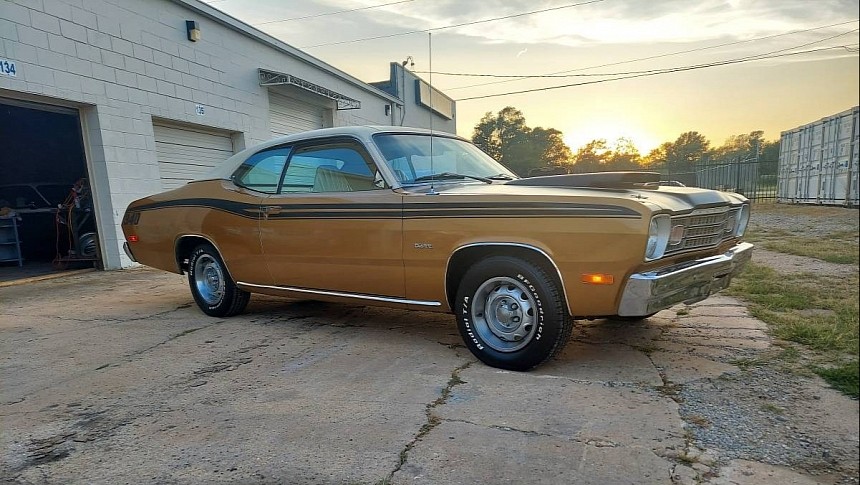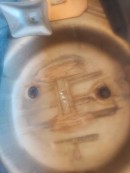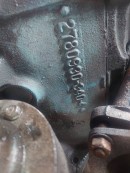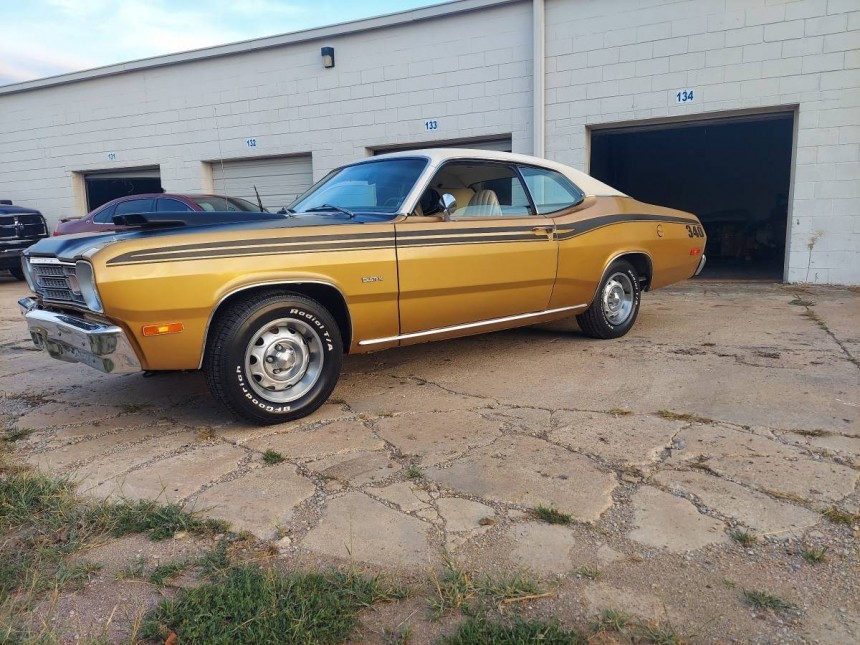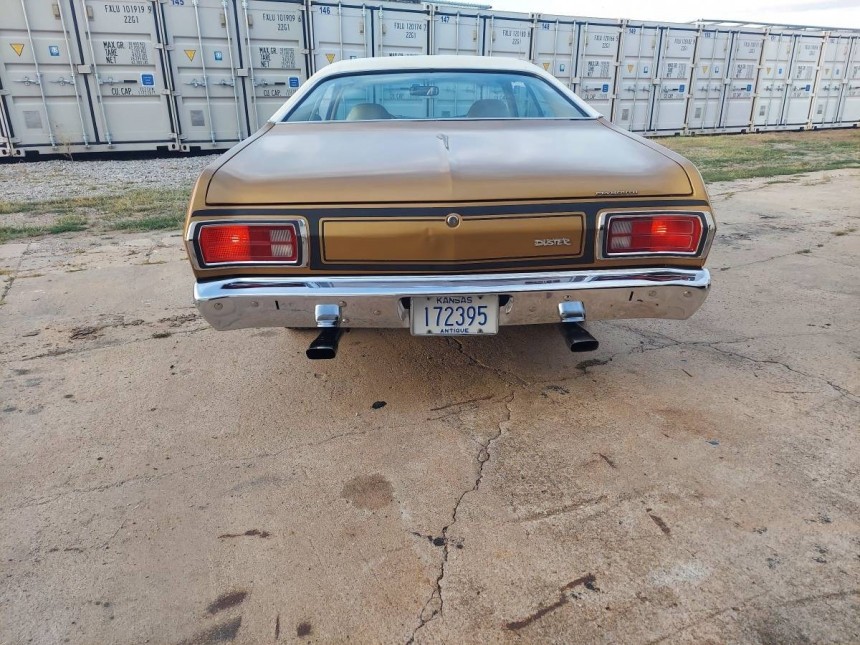When the insurance companies caught up with the carmaking industry’s tendency to sweet-talk their way out of unaffordable premiums, the muscle car era was already coming to a close. Detroit retaliated by rolling out smaller, lighter cars with a stingy punch, and the Plymouth Duster is the best example of this trend.
Based on the sales workhorse Valiant, the Duster was meant to spice up the image of the low-budget Plymouth while also keeping the price down. Launched in 1970, it was canceled mid-year in 1976 after a successful and enthusiastic start that saw an average of over 200,000 units per year in the first five model years.
The Plymouth Duster was a tremendous bang-for-your-buck value muscle car. It was more affordable than the Road Runner by a few hundred dollars and offered decent performance with a 275-horsepower 340 V8 for the first years. When emissions restrictions stuck their tails in the carmaking business, the punchy 340 was terminated in 1973.
To further hammer the nails in the Duster’s coffin, Chrysler suddenly added some hundred to the vehicle’s price tag starting in 1975, and the result of this stroke of genius marketing was immediate. The car’s sales dropped from the all-time best of 281,000 in 1974 to a little over 120,000 in the following year.
Curiously, in 1974, the 340 eight-cylinder engine was not offered – and it had been the best part about a Duster for the first four years. The little 340 cubic-inch V8 (5.6 liters) came with a four-barrel carburetor and produced 275 hp and 340 lb-ft until 1972. Restrictions detuned the car to 240 hp and 290 lb-ft in ’72 and further smothered output the following year to 235 hp. Strangely, torque went up to 295 lb-ft.
The ‘two-door Valiant’ bid farewell to its ‘340’ badge in late 1973, effectively ending the Duster 340 nameplate, which had been the hot model in the previous years. Plymouth proudly sported the engine displacement on the cars, with big decals showing off its superiority over blue-collared, regular, everyday, average Dusters.
Today, Dusters are probably the most affordable collectible muscle cars from the 1970s, and here is one that can testify to this. With less than 42,000 miles on the clock, this Mopar is allegedly all original, but what’s really interesting and exciting about it is the price. Located in Wichita, Kansas, this splendor is available on Craigslist for $35,900. A December ‘72 assembly, this time capsule of a Mopar wears its original sheet metal with rust-proof dignity. Not too many Dusters can claim that performance since it was common knowledge among Mopar guys that the Valiant spin-off was incredibly environment-aware. The cars would give in to the elements with such frenzy that they earned the nickname ‘Ruster’ in climates where corrosion would bite off chunks of it over a single winter.
The seller has a strong point when claiming that the price is more than reasonable - why spend $80k on a restoration when you can have this road-ready Mopar for less than half the money? The 340 CID V8 powered nearly 217,000 Chrysler Corp automobiles between 1968 and 1973. Curiously, its last year on the market was also the second-best in sales. 15,731 Duster 340s rolled off the production lines, with 11,000 more in the Dodge interpretation, the Dart Sport (formerly known as the Demon 340).
The hero of our story was finished in December 1972 and has several unusual options installed – like the air conditioning, power steering, and the console shifter for its three-speed TorqueFlite automatic transmission. The astute observer will probably have a say about the difference in color between the rear and front clips. It could be something as simple as the primer – Chrysler might have used two distinct shades, one on the front fenders and doors and another for the back end.
As for where the bumper guards are – since the ‘73s had the bumpers with rubber shock absorbers on them – that’s a question for the seller. Chrysler found a workaround for the then-new government bumper requirement by installing big bumper guards. The bumper crash tests were conducted in a relatively straightforward manner - literally hitting a flat barrier head-on.
Even though 1973 was the final year of the 340 V8, the engine had already been detuned a year before, with a decrease in compression ratio from 10.2:1 to 8.5:1. Also, the intake valves shrunk from 2.02 inches (51 mm) to 1.88 inches (48 mm). Ultimately, the choice was simple – the economy-oriented buyers could opt for the 318-CID (5.2-liter) V8 or one of the two Slant Sixes (the 198 cu-in or the 225 cu-in). Those who wanted a bit more fun were going for the 360 V8 that replaced the famed 340 after 1973. Rather than keeping a neutered 340 alive for the sake of it, Chrysler made a cold-hearted decision and wrote off its feisty motor.
The Plymouth Duster was a tremendous bang-for-your-buck value muscle car. It was more affordable than the Road Runner by a few hundred dollars and offered decent performance with a 275-horsepower 340 V8 for the first years. When emissions restrictions stuck their tails in the carmaking business, the punchy 340 was terminated in 1973.
To further hammer the nails in the Duster’s coffin, Chrysler suddenly added some hundred to the vehicle’s price tag starting in 1975, and the result of this stroke of genius marketing was immediate. The car’s sales dropped from the all-time best of 281,000 in 1974 to a little over 120,000 in the following year.
The ‘two-door Valiant’ bid farewell to its ‘340’ badge in late 1973, effectively ending the Duster 340 nameplate, which had been the hot model in the previous years. Plymouth proudly sported the engine displacement on the cars, with big decals showing off its superiority over blue-collared, regular, everyday, average Dusters.
Today, Dusters are probably the most affordable collectible muscle cars from the 1970s, and here is one that can testify to this. With less than 42,000 miles on the clock, this Mopar is allegedly all original, but what’s really interesting and exciting about it is the price. Located in Wichita, Kansas, this splendor is available on Craigslist for $35,900. A December ‘72 assembly, this time capsule of a Mopar wears its original sheet metal with rust-proof dignity. Not too many Dusters can claim that performance since it was common knowledge among Mopar guys that the Valiant spin-off was incredibly environment-aware. The cars would give in to the elements with such frenzy that they earned the nickname ‘Ruster’ in climates where corrosion would bite off chunks of it over a single winter.
The hero of our story was finished in December 1972 and has several unusual options installed – like the air conditioning, power steering, and the console shifter for its three-speed TorqueFlite automatic transmission. The astute observer will probably have a say about the difference in color between the rear and front clips. It could be something as simple as the primer – Chrysler might have used two distinct shades, one on the front fenders and doors and another for the back end.
As for where the bumper guards are – since the ‘73s had the bumpers with rubber shock absorbers on them – that’s a question for the seller. Chrysler found a workaround for the then-new government bumper requirement by installing big bumper guards. The bumper crash tests were conducted in a relatively straightforward manner - literally hitting a flat barrier head-on.
Even though 1973 was the final year of the 340 V8, the engine had already been detuned a year before, with a decrease in compression ratio from 10.2:1 to 8.5:1. Also, the intake valves shrunk from 2.02 inches (51 mm) to 1.88 inches (48 mm). Ultimately, the choice was simple – the economy-oriented buyers could opt for the 318-CID (5.2-liter) V8 or one of the two Slant Sixes (the 198 cu-in or the 225 cu-in). Those who wanted a bit more fun were going for the 360 V8 that replaced the famed 340 after 1973. Rather than keeping a neutered 340 alive for the sake of it, Chrysler made a cold-hearted decision and wrote off its feisty motor.
